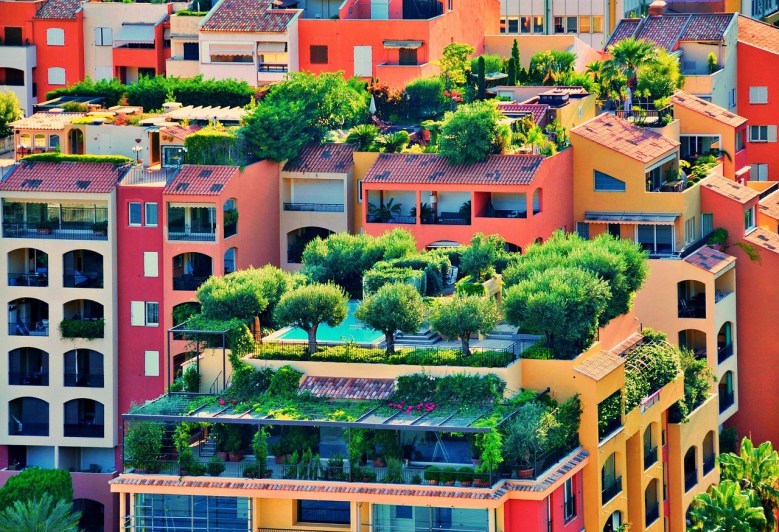Disclosure: As an Amazon Associate I earn from qualifying purchases. This page may contain affiliate links, which means I may receive a commission if you click a link and purchase something that I have recommended. There is no additional cost to you whatsoever.
July 6, 2020
What is a rooftop garden?
No surprise here. A rooftop garden is exactly what it sounds like, a garden that happens to be on a roof. Sometimes this means flowers and shrubs or even a vegetable, herb or fruit garden.
Humans have been gardening on the roofs of structures for centuries dating back to the ziggurats of Mesopotamia (600 BC). While the practice is not new, as urbanization has swept the globe, more and more people are looking for ways to reduce their ecological footprint, maximize space, and to add some natural beauty to their homes.
Whatever the reason, rooftop gardening offers a ton of benefits.
Benefits of rooftop gardens

The size of your rooftop space dictates how much of an impact your garden will have. But no matter the size, caring for a rooftop garden is a therapeutic way to help reduce your footprint on the world.
Reducing Energy Use
One of the primary causes of heat build-up in urban areas is insolation. Buildings and roads absorb heat and subsequently radiate heat that drives up temperatures. In turn, more energy has to be used to cool the surrounding homes and businesses. In fact, 16% of the total residential energy usage in the U.S. is from heating and cooling
Because of the natural transpiration nature of plants, they actually absorb heat and stop ambient temperatures from rising. A study by Cardiff University found that green rooftops can reduce peak temperatures by as much as 11°C.
In short, if we reduce warm ambient temperatures there is less demand for cooling, resulting in less demand for energy.
Climate change adaptation
In addition to urban areas absorbing and radiating heat, climate change means there is and will continue to be more heat to absorb. More and more people will find themselves in extreme heat zones in the next few decades.
This means that summer temperatures and associated urban heat islands are expected to worsen. Anything we can do to dissipate heat could be a vital part of combating urban heat zones. Green roofs are one of the most effective ways of combating the urban heat island effect.
Wildlife habitats
Green roofs also help support wildlife by giving urban concrete jungles a dose of green space. While they can’t entirely replace natural green space, they’re perfect for attracting birds, squirrels, and other wildlife to create a thriving eco-friendly habitat.
Each green roof will support varying habitats, dependent largely on the type of vegetation included. According to a survey in Switzerland, a study of 11 green rooftops found there to be an incredible 172 separate species.
Improved air quality
Air pollution plagues urban areas around the world. The World Health Organization estimates that air pollution kills seven million people each year. As you would expect, air pollution is a greater problem in urban areas, especially the larger cities such as London, Los Angeles, Manila, New York City and Paris.
How to get started with rooftop gardening

Space needed
There are two types of rooftop gardens: fully planted or containers/raised beds. Fully planted gardens are typically more difficult to start and maintain because it requires covering the roof with soil and often requires an evaluation by an engineer to make sure the roof can support the weight of so much soil and water.
Raised bed and container gardens are much more simple. Just find some garden containers that fit your space, add soil, and job done! Since most of us aren’t master gardeners starting with a small container can be a good way to get your feet wet with this new hobby.
Cost to start a rooftop garden
Depending on how big you plan to make your rooftop garden will determine the cost. If you build a fully planted garden to cover a large roof you could spend thousands on proper irrigation and engineering.
However, a more modest garden with a few containers and plants can be created with even the smallest budget. Containers and soil will generally be the most expensive items needed to get started, so don’t be scared to get creative. Building your own containers is easy and if you’re not the handy type, you can recycle household items like buckets as planters.
Rooftop garden maintenance

The idea of maintaining a garden stops a lot of people from getting started. But there is some good news.
With some simple planning, your rooftop garden can almost care for itself.
Your local climate will determine which plants will naturally thrive, but here are a few tips to make your garden as low maintenance as possible:
- Use native plants – native plants are more likely to thrive and take less effort to maintain.
- Use water timers – smart water facets allow you to water your plants from your phone by setting a schedule and even use weather reports to make sure they get the perfect amount of water.
- Start small – start with one or two small planters and then expand if you enjoy your new garden.
Rooftops gardens really can help us to make the world a better and greener place. If you have the chance – then start creating one today.

Jeff Long is a Senior Editor at BusinessChew. He writes about trends in technology and business that impact the world including clean energy.








